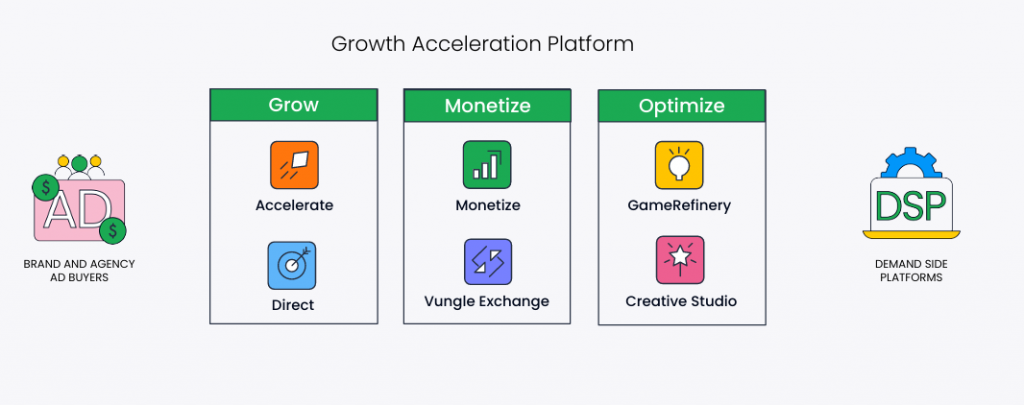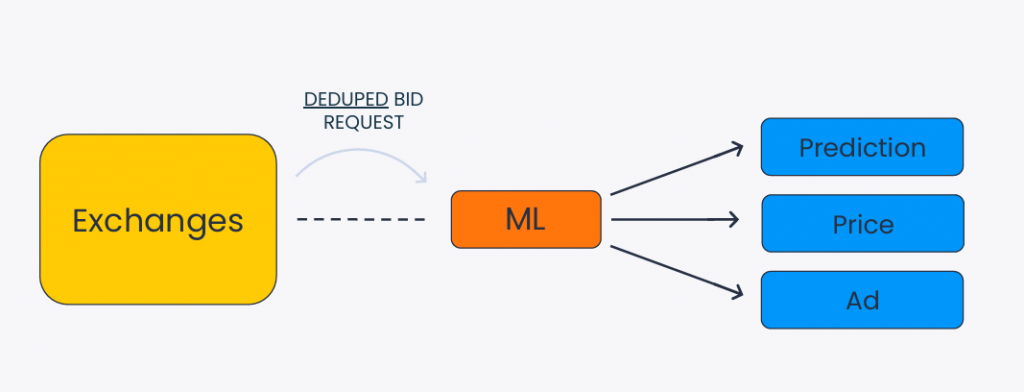Rebuilding User Acquisition Through Programmatic Infrastructure: Results from the Ukrainian Market
User acquisition in performance-driven verticals depends on more than just competitive bids and strong creatives. Real scalability emerges only when the advertising ecosystem is engineered so that every signal, every creative variation, and every supply-path interaction supports clear optimization logic. In markets like Ukraine, where user quality is uneven and device distribution varies widely, the stability of machine-learning systems becomes the decisive factor in determining whether a campaign reaches its potential or collapses during early learning phases.
This case focuses on a real performance campaign conducted in Ukraine through a machine-learning-driven programmatic advertising platform, with ScroogeFrog Agency responsible for the strategic architecture, operational supervision, and performance management. The advertiser is not named; the emphasis is placed entirely on the practical implementation and the measurable outcomes that emerged once the acquisition environment was rebuilt correctly.
The goal was not simply to launch ads, but to create a predictable, data-driven, and optimization-friendly ecosystem capable of generating high-intent traffic at scale — and to do so in a GEO known for volatility in cost benchmarks and strong fluctuations in user behavior.
Market Context and Product Dynamics

The promoted product operated within a category defined by high engagement potential but sensitive to signal quality. Conversions beyond the install — including registration, deposit, and first-time deposit (FTD) — determine real profitability. For the programmatic engine to optimize toward these deeper actions, it must receive stable, structured data and operate in an environment where it can recognize patterns among millions of impressions.
Ukraine presents unique challenges. The market includes:
- A broad split between low-cost Android inventory and more limited high-value iOS supply
- Strong seasonal fluctuations affecting CPMs and click-through behavior
- High levels of competition in peak periods
- Noticeable differences in user lifetime value depending on device class and creative entry point
For these reasons, the platform’s machine-learning models need sustained exposure, controlled exploration, and consistent post-install feedback. Without this, the algorithm tends to gravitate toward low-quality suppliers, prioritizing volume over meaningful actions.
The advertiser’s initial attempts reflected this problem: campaigns generated traffic, but the distribution of post-install signals was irregular, making it impossible for the system to understand which impressions were linked to deeper conversion behavior.
Challenges Before ScroogeFrog’s Involvement

The advertiser launched the programmatic campaigns independently, but the absence of structured optimization logic created fragmentation at every stage.
Signals were incomplete and inconsistent, depriving the algorithm of the clarity required to differentiate high-intent users from low-engagement segments. Creative rotation lacked a strategy, leading to noisy performance data. Budgets were paced unevenly, causing the platform’s learning phases to reset prematurely. Supply sources, left unsupervised, continued to route impressions through low-probability inventory, even when deeper conversions clearly originated from other placements.
The result was predictable: unstable CPIs, unpredictable registration behavior, inconsistent deposit patterns, and no coherent path toward FTD optimization.
Without intervention, the campaign would have continued generating volume but not value.
ScroogeFrog’s Strategic Reconstruction of the UA System

The turning point came when ScroogeFrog restructured the entire user acquisition environment. Rather than altering a few parameters or creatives, the agency rebuilt the underlying logic that governs how the machine-learning system interprets behavior, evaluates supply, and assigns bid values.
The first step involved realigning the account architecture. Campaigns were reorganized according to function, with clear divisions between exploration, acquisition, and scaling flows. Each type of campaign was allowed to operate within a fixed learning window so that the algorithm could collect stable patterns instead of oscillating between unrelated events.
Equally critical was the engineering of post-install signals. ScroogeFrog ensured that the events sent to the platform — installs, registrations, deposits, and FTDs — were passed with consistency and accuracy. Instead of scattered or delayed data, the system began receiving a continuous stream of well-structured signals, allowing it to correlate specific device clusters, supply sources, and creative vectors with deeper-conversion likelihood.
Creative management was then rebuilt with precision. ScroogeFrog implemented a controlled testing framework in which creatives entered learning pools in measured intervals and were suppressed before they distorted the algorithm’s scoring logic. This prevented low-performing assets from consuming budget and preserved the integrity of the optimization environment. The algorithm could now evaluate creatives based on their true contribution to deposit and FTD probability.
Supply-path optimization played an essential role. The platform, when guided correctly, can identify which exchanges, publishers, and placements consistently lead to meaningful outcomes. This refined the bid landscape and increased the algorithm’s precision.

Finally, budgeting and pacing were redesigned to maintain algorithmic stability. ScroogeFrog ensured that learning cycles were not interrupted by abrupt changes in spend, preventing resets and improving long-term predictability.
Taken together, these interventions created an ecosystem where the programmatic engine could operate at full capability.
Execution in the Ukrainian Market
With the new structure fully implemented, ScroogeFrog activated the campaign across Ukraine, supervising each stage of the rollout. Budgets were paced to maintain ideal signal density, creatives were introduced in controlled cycles, and the algorithm was allowed to evaluate behavior before any strategic adjustments were made.
As the system learned, several trends became clear. Ukrainian traffic contains pockets of extremely high-value users, but these segments remain invisible until the platform receives stable post-install signals. To ensure this level of visibility, we typically work with a minimum commitment of $30,000, as the machine-learning system requires 30–100 unique conversion events before it can reliably optimize toward CPA. Once ScroogeFrog’s structure enabled the platform to accumulate these events consistently, the algorithm quickly reweighted bids to favor sources correlated with deposit behavior while suppressing low-intent streams entirely.
The campaign generated substantial real event volume:
Campaign Performance Data
| Metric | Value |
| Spend | 86,240.88 |
| Clicks | 22,066,181 |
| Installs | 5,151 |
| Registrations | 928 |
| Deposits | 8,914 |
| First-Time Deposits | 766 |
These metrics highlight several important dynamics.
The install volume, relative to total traffic, reflects market realities: Ukrainian supply includes considerable low-cost inventory that produces clicks efficiently but does not always translate into installs. However, once installs occurred, down-funnel behavior was remarkably strong. The large number of deposits compared to registrations demonstrates that users who converted were not only engaged but ready to transact. The FTD count confirms that the algorithm successfully identified segments with genuine payment intent.
Most importantly, these results were not incidental. They emerged only after the acquisition logic was restructured so that the platform could learn from real behavioral patterns instead of surface-level indicators.
How ScroogeFrog’s Work Transformed the Outcome
The improvements observed during the campaign were the direct consequence of creating a fully coherent optimization environment.
With a reliable flow of post-install data, the algorithm stopped bidding blindly and began assigning value to impressions based on statistical correlations with deposits and FTDs. Creative scoring became accurate once noise was removed. Supply optimization ensured that the budget was routed toward inventory with historical conversion probability rather than toward the lowest CPM. Budget pacing maintained consistent learning cycles rather than forcing unpredictable resets.
Instead of reacting to CPI spikes or rapid changes in conversion rates, ScroogeFrog evaluated the system holistically, focusing on long-term value indicators. This approach allowed the programmatic engine to converge on a stable equilibrium where the advertiser’s objectives and the algorithm’s optimization logic were aligned.
The Ukrainian market—often difficult for non-structured campaigns—became a predictable environment for generating high-intent users.
Conclusion

This case demonstrates that the success of programmatic user acquisition is determined not by isolated optimizations, but by the structure and integrity of the entire advertising ecosystem. In Ukraine, where traffic is abundant but uneven, campaigns fail when machine-learning systems operate without clean signals, consistent creative logic, or controlled supply paths.
Once ScroogeFrog reconstructed the acquisition architecture, the platform could finally evaluate, learn, and scale accurately. The result was a campaign capable of producing strong deposit behavior, meaningful FTD volume, and a predictable foundation for further expansion — something unattainable before the intervention.





